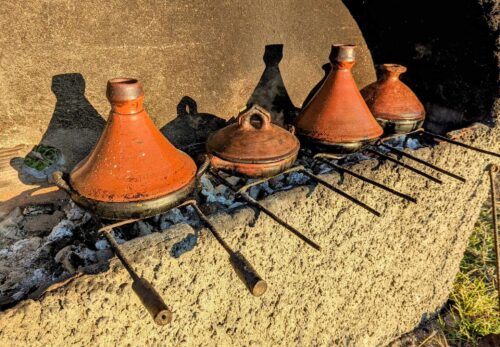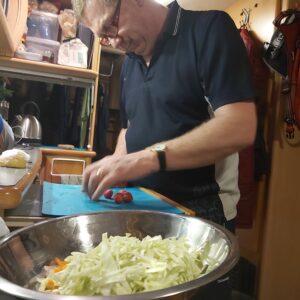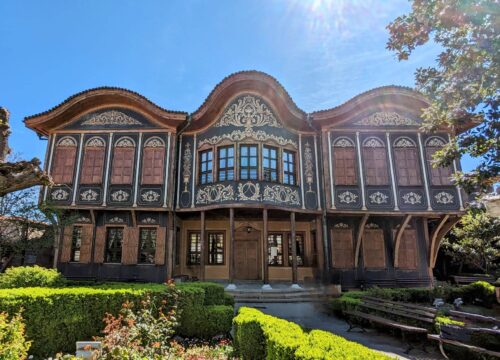Morocco Collection
Tagine

Tagine is a traditional North African cooking method that has been used for centuries. It involves the use of a conical earthenware pot, also known as a tagine pot, which is commonly used in countries such as Morocco. The tagine pot is used to prepare daily meals, and the food that is cooked in it is called tagine. The pot gets its conical shape from the fact that steam rises from the food and gets trapped in the cone, eventually falling back down into the dish. This results in a dish that is rich in flavor and aroma.
The tagine pot has a rich history and was originally used as a “portable oven” by the nomads of North Africa. This allowed them to prepare food while on the move, at any time. Today, the tagine pot is still widely used in North African homes and restaurants. The dish cooked in the tagine pot is often a combination of meat, vegetables, and spices, which are slow-cooked to perfection, resulting in a dish that is tender and bursting with flavour.
In summary, tagine is not just a dish, but a cooking method that has been passed down through generations in North Africa. It is a unique way of cooking that results in a dish that is both flavourful and aromatic, and the tagine pot is an essential tool for any cook who wants to create authentic North African dishes.
Tagine, the iconic food of Morocco
The tagine is a beautiful and traditional cooking vessel that consists of two parts: a wide and shallow base and a conical cover that creates a unique and elegant appearance. Historically, it was used as a clay oven that would be placed on hot coals, creating a slow and even cooking experience for the food placed inside. The steam that arises from the cooking process would condense in the cone and drip back down into the dish, creating an optimal basting effect that keeps the ingredients moist and tender.
While tagines can also be used over a gas flame, they are not recommended for direct heat and are prone to cracking. To avoid this, a diffuser pad should be used to disperse the heat evenly. It is also important to soak a new tagine in water for 24 hours before its first use to prevent cracking.
Traditionally, tagines were made of earthenware, and the unglazed ones were used for cooking while the decorated ones were reserved for serving. They are found in countless homes across Morocco, with each household having its own family recipe. Some recipes involve browning the meat or softening the onions before adding them to the tagine, while others involve layering all the ingredients and cooking them slowly over low heat. The exact ingredients used in a tagine can vary based on what is available on the day, but the result is always a delicious and fragrant dish that is perfect for sharing with family and friends.

Tagine
Equipment
- 1 Tagine or Dutch Oven
Ingredients
- 4 chicken portions or protein of your choice.
- 2 carrots
- 2 potato
- 2 turnip
- 50 g green beans
- 1 aubergine
- 1 red onion sliced
- 2 tomato chopped
- chopped parsley
- chopped coriander
- 1 clove garlic pressed
- 2 tbsp olive oil
- 200 ml water adjust depending on evaporation
Spices
- 1 tsp ground ginger
- 1 tsp ground turmeric
- 1 tsp ground cumin
- 1/4 tsp ground cinnamon
Instructions
- place onions, garlic, tomato on base of tagine with a dash of oil and water
- arrange meat in centre of the tagine, on top of the onions/tomato
- sprinkle over your spices/seasoning
- arrange vegetables around the meat in a kind of pyramid
- more chopped tomato and fresh herbs on top
- cover with the lid and cook over a low heat. Cooking time will depend on the protein used: Chicken, about 1 hour; lamb on the bone at least 3 hours
- Check periodically that the tagine hasn't dried out, adding a little water as necessary
- The vegetables will be soft – they are meant to be!
Notes
Why not have a look at my other sites....
Helping you save money on your everyday bills
Balancing finances isn’t easy. Often there doesn’t seem enough to go around, or there’s little left for the important things in life.
We would all like a bit extra to spend on the things we want to do, and it’s possible with a bit of thrifty living. This site is packed with hints and tips to save money, allowing you to do more of what you want.
Answering p-mails the world over
An ex street dog from Cyprus, an ex-pub dog from Devon, ex ex-overnight security dog and now enjoying my time travelling with my mum and dad.
My hoomans and I explore the world in their big white box on wheels, although that work fing gets in the way sometimes. So far we have travelled mostly around Europe, but have also been to Morocco in Africa.
Hope You Enjoy!
Please leave me a comment!



